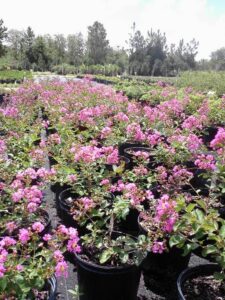S & J Nursery’s Guide to Growing
Pink Sioux Crape Myrtle
in the Northeast Florida Landscape
( Lagerstroemia indica ‘Sioux)
 Crape Myrtle Sioux Preferred Exposure:
Crape Myrtle Sioux Preferred Exposure:
– Full sun is needed for Sioux Crape Myrtles to grow and bloom properly in the North Florida | Jacksonville | St. Augustine area gardens landscape.
Sioux Crape Myrtle Foliage | Bark:
– Lush green foliage turns purple in the fall before falling off the tree for the
winter season! Really showy.
– Bark of the Sioux Crape Myrtle is a smooth textured mottled tan color.
Sioux Crape Myrtle Soil Preference / Salt Tolerance:
– Sioux Crape Myrtles do well in most soils providing they are well draining.
– Crape Myrtles are not known to be salt tolerant and should not be planted in areas where salt spray will reach them from the ocean or where highly saline water is used for irrigating.
Sioux Crape Myrtle Size Variance:
– Sioux Crape Myrtle is a medium growing selections and will grow up to15-20 feet high and 0-15 feet wide.
Crape Myrtle Sioux Growth Habit:
– Upright oval growth habit forms a pretty crown of blooming foliage.
Crape Myrtle Sioux Growth Rate:
– Lagerstroemia Sioux is a moderate growing selection of Crape Myrtle. You can expect a foot or more in a single growing season from this variety in the North Florida Jacksonville | St. Augustine area landscape.
Sioux Crape Myrtle Bloom:
– With all the varieties of Crape Myrtles on the market today not to mention the over 14 varieties we currently have in stock at S & J Nursery, describing the colors of a Crape Myrtles bloom can often be difficult and take some inventive thinking. I love it when someone asks about Sioux, its just
so easy, its the color of a good old fashioned piece of bubble gum. No raspberry tinged or pale or soft lavender descriptions needed. Its just pink! Bubble gum pink. And its pretty!
Crape Myrtle Sioux Water Requirements:
-Crepe Myrtles trees are drought tolerant after they are established in the
landscape but will need to be watered well after planting for two weeks to three months in the establishment period depending on the size of the tree being planted and during prolonged periods of drought after established
in the landscape.
Butterfly or Bird Attracting:
– Hummingbird attracting
 Best Uses For Crape Myrtles:
Best Uses For Crape Myrtles:
– Few trees make quite the statement in the landscape that a Crape Myrtle can. They bloom for months with little care on our part to keep them looking spectacular. Its little wonder they hold such a place in our hearts and in our gardens.
– Plant them alone as a specimen accent or in groups for added dramatic flare. With so many varieties, colors and sizes to choose from, no southern garden should be without at least one!
– Crape Myrtles are the perfect touch of color when inter planted in hedge rows for privacy screens or property borders.
– Low maintenance and drought tolerant once established, Crape Myrtles make excellent commercial plantings for parking lots and street trees.
Care of Crape Myrtles:
– Water every day during the establishment period. See watering your newly planted trees for more information.
-They will need good water during the establishment period and supplemental irrigation during dry spells or particularly hot dry summers.
– All Crape Myrtles bloom on new wood and should be pruned in winter or early spring for best bloom.
– Take care to remove basal suckers and small twiggy growth each year on larger specimens and remove crossing or touching branch growth as well as branches growing towards the center rather than the more desirable growth that grows out and away from other branches.
– During the summer growth season you can choose to trim old blooms and your Crape Myrtle will put out a second lighter and slightly smaller bloom to replace it and prolong your bloom season.
– Provide a 1 ft diameter circle of mulched area where grass is kept from growing for each inch of caliper (or diameter) of trunk measured 4 inches from the ground level.
– Fertilize each spring with a heaping shovel of compost or a mixture of Milorganite and a slow release poly coated plant food such as Osmocote or Stay Green general purpose plant food, sprinkling the fertilizer around the mulch circle underneath the foliage of the tree.

